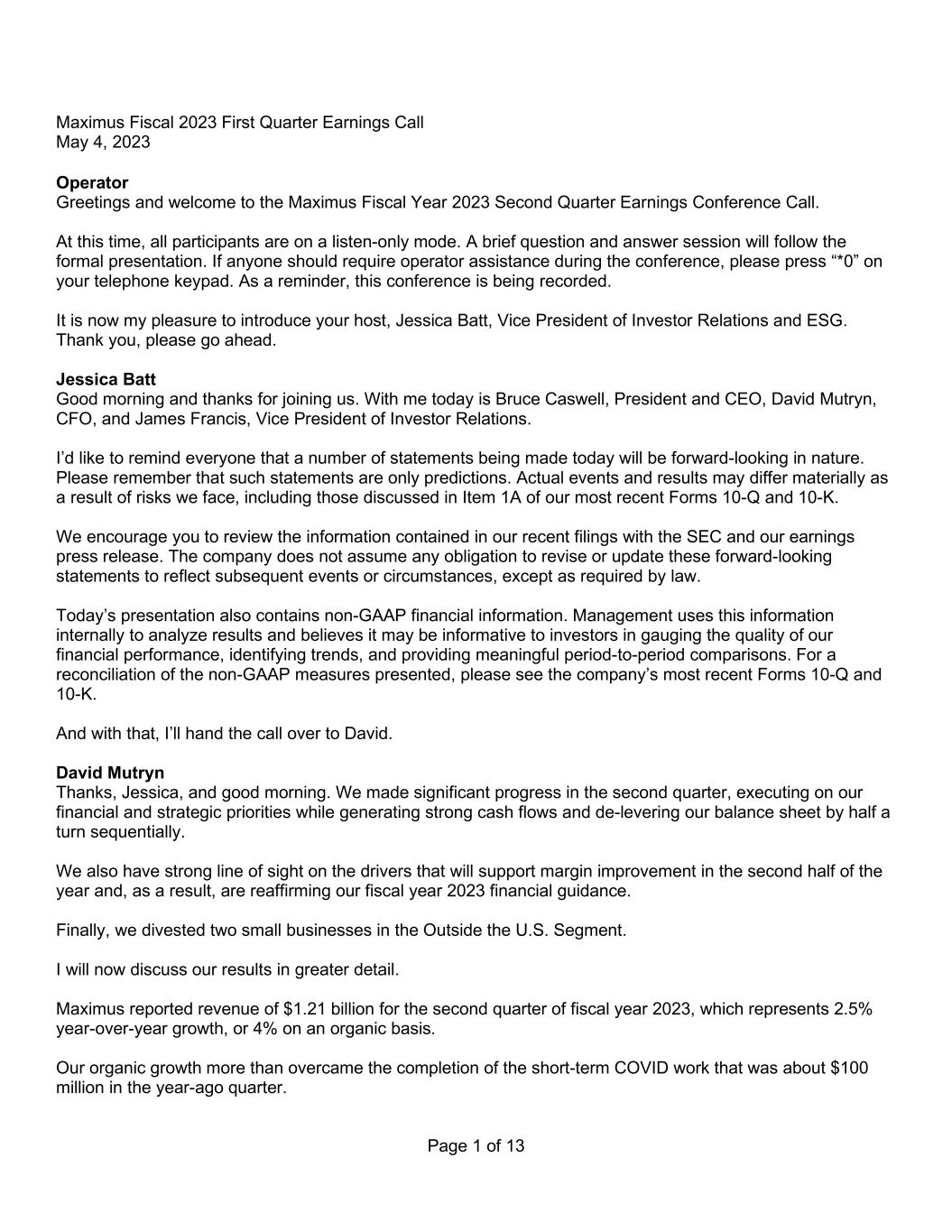
Maximus Fiscal 2023 First Quarter Earnings Call May 4, 2023 Page 1 of 13 Operator Greetings and welcome to the Maximus Fiscal Year 2023 Second Quarter Earnings Conference Call. At this time, all participants are on a listen-only mode. A brief question and answer session will follow the formal presentation. If anyone should require operator assistance during the conference, please press “*0” on your telephone keypad. As a reminder, this conference is being recorded. It is now my pleasure to introduce your host, Jessica Batt, Vice President of Investor Relations and ESG. Thank you, please go ahead. Jessica Batt Good morning and thanks for joining us. With me today is Bruce Caswell, President and CEO, David Mutryn, CFO, and James Francis, Vice President of Investor Relations. I’d like to remind everyone that a number of statements being made today will be forward-looking in nature. Please remember that such statements are only predictions. Actual events and results may differ materially as a result of risks we face, including those discussed in Item 1A of our most recent Forms 10-Q and 10-K. We encourage you to review the information contained in our recent filings with the SEC and our earnings press release. The company does not assume any obligation to revise or update these forward-looking statements to reflect subsequent events or circumstances, except as required by law. Today’s presentation also contains non-GAAP financial information. Management uses this information internally to analyze results and believes it may be informative to investors in gauging the quality of our financial performance, identifying trends, and providing meaningful period-to-period comparisons. For a reconciliation of the non-GAAP measures presented, please see the company’s most recent Forms 10-Q and 10-K. And with that, I’ll hand the call over to David. David Mutryn Thanks, Jessica, and good morning. We made significant progress in the second quarter, executing on our financial and strategic priorities while generating strong cash flows and de-levering our balance sheet by half a turn sequentially. We also have strong line of sight on the drivers that will support margin improvement in the second half of the year and, as a result, are reaffirming our fiscal year 2023 financial guidance. Finally, we divested two small businesses in the Outside the U.S. Segment. I will now discuss our results in greater detail. Maximus reported revenue of $1.21 billion for the second quarter of fiscal year 2023, which represents 2.5% year-over-year growth, or 4% on an organic basis. Our organic growth more than overcame the completion of the short-term COVID work that was about $100 million in the year-ago quarter.
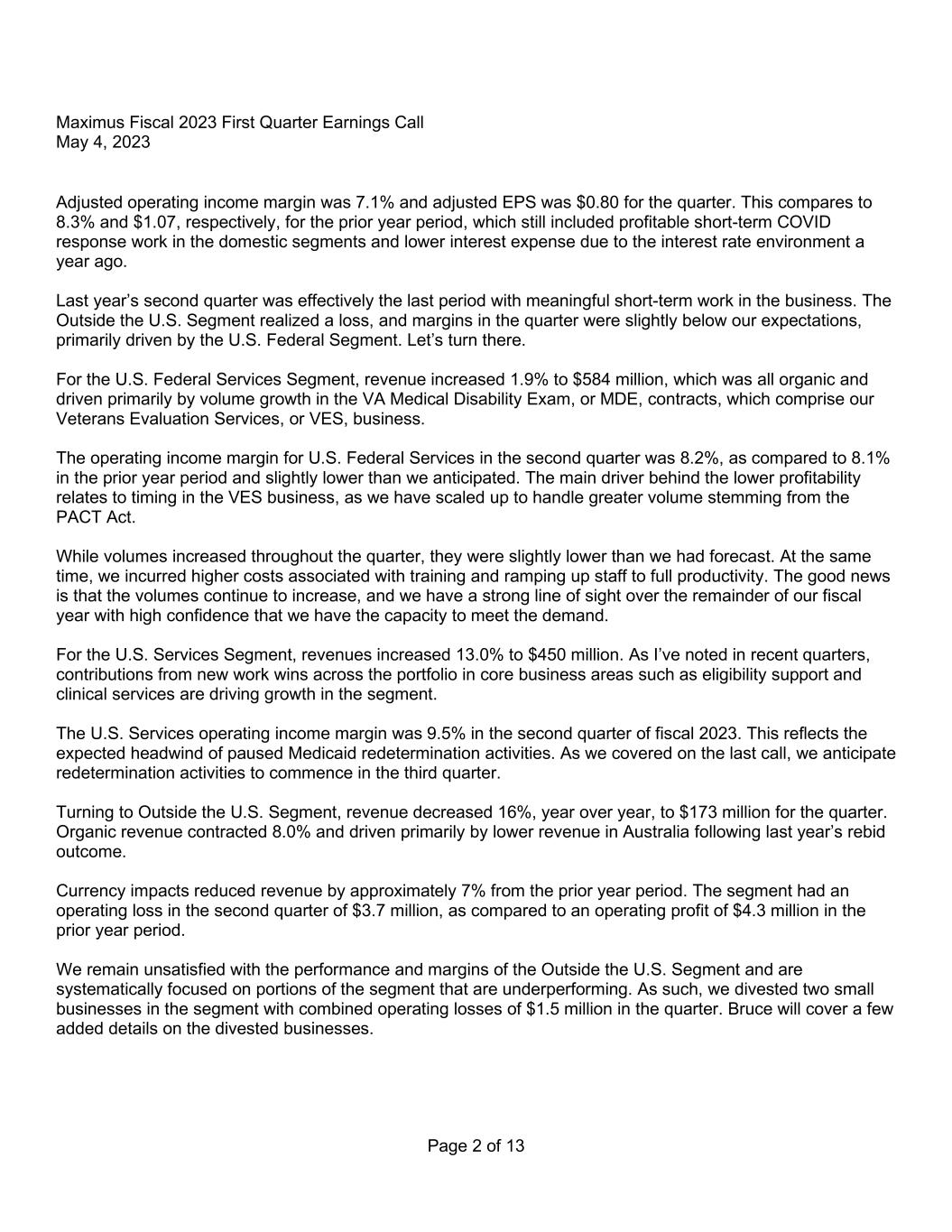
Maximus Fiscal 2023 First Quarter Earnings Call May 4, 2023 Page 2 of 13 Adjusted operating income margin was 7.1% and adjusted EPS was $0.80 for the quarter. This compares to 8.3% and $1.07, respectively, for the prior year period, which still included profitable short-term COVID response work in the domestic segments and lower interest expense due to the interest rate environment a year ago. Last year’s second quarter was effectively the last period with meaningful short-term work in the business. The Outside the U.S. Segment realized a loss, and margins in the quarter were slightly below our expectations, primarily driven by the U.S. Federal Segment. Let’s turn there. For the U.S. Federal Services Segment, revenue increased 1.9% to $584 million, which was all organic and driven primarily by volume growth in the VA Medical Disability Exam, or MDE, contracts, which comprise our Veterans Evaluation Services, or VES, business. The operating income margin for U.S. Federal Services in the second quarter was 8.2%, as compared to 8.1% in the prior year period and slightly lower than we anticipated. The main driver behind the lower profitability relates to timing in the VES business, as we have scaled up to handle greater volume stemming from the PACT Act. While volumes increased throughout the quarter, they were slightly lower than we had forecast. At the same time, we incurred higher costs associated with training and ramping up staff to full productivity. The good news is that the volumes continue to increase, and we have a strong line of sight over the remainder of our fiscal year with high confidence that we have the capacity to meet the demand. For the U.S. Services Segment, revenues increased 13.0% to $450 million. As I’ve noted in recent quarters, contributions from new work wins across the portfolio in core business areas such as eligibility support and clinical services are driving growth in the segment. The U.S. Services operating income margin was 9.5% in the second quarter of fiscal 2023. This reflects the expected headwind of paused Medicaid redetermination activities. As we covered on the last call, we anticipate redetermination activities to commence in the third quarter. Turning to Outside the U.S. Segment, revenue decreased 16%, year over year, to $173 million for the quarter. Organic revenue contracted 8.0% and driven primarily by lower revenue in Australia following last year’s rebid outcome. Currency impacts reduced revenue by approximately 7% from the prior year period. The segment had an operating loss in the second quarter of $3.7 million, as compared to an operating profit of $4.3 million in the prior year period. We remain unsatisfied with the performance and margins of the Outside the U.S. Segment and are systematically focused on portions of the segment that are underperforming. As such, we divested two small businesses in the segment with combined operating losses of $1.5 million in the quarter. Bruce will cover a few added details on the divested businesses.
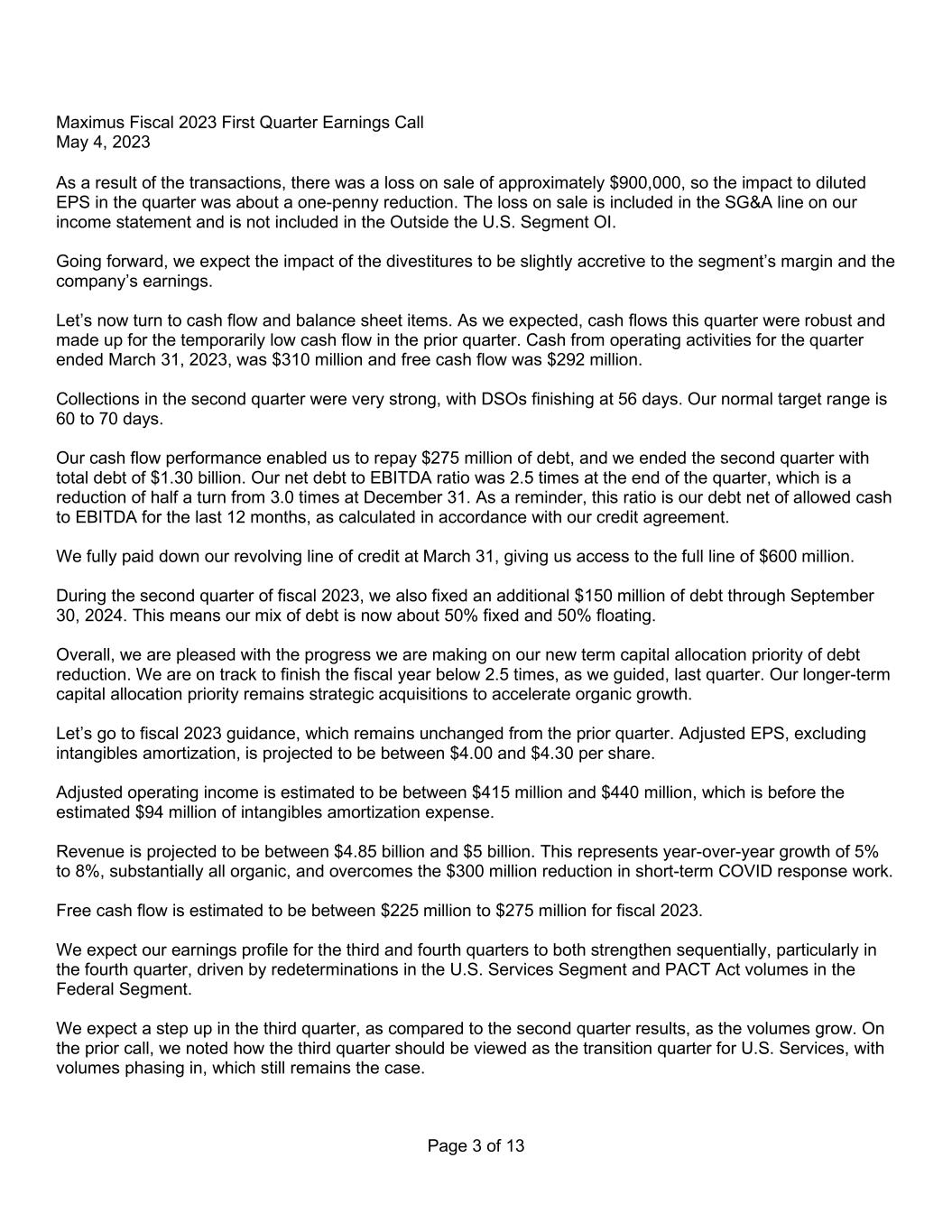
Maximus Fiscal 2023 First Quarter Earnings Call May 4, 2023 Page 3 of 13 As a result of the transactions, there was a loss on sale of approximately $900,000, so the impact to diluted EPS in the quarter was about a one-penny reduction. The loss on sale is included in the SG&A line on our income statement and is not included in the Outside the U.S. Segment OI. Going forward, we expect the impact of the divestitures to be slightly accretive to the segment’s margin and the company’s earnings. Let’s now turn to cash flow and balance sheet items. As we expected, cash flows this quarter were robust and made up for the temporarily low cash flow in the prior quarter. Cash from operating activities for the quarter ended March 31, 2023, was $310 million and free cash flow was $292 million. Collections in the second quarter were very strong, with DSOs finishing at 56 days. Our normal target range is 60 to 70 days. Our cash flow performance enabled us to repay $275 million of debt, and we ended the second quarter with total debt of $1.30 billion. Our net debt to EBITDA ratio was 2.5 times at the end of the quarter, which is a reduction of half a turn from 3.0 times at December 31. As a reminder, this ratio is our debt net of allowed cash to EBITDA for the last 12 months, as calculated in accordance with our credit agreement. We fully paid down our revolving line of credit at March 31, giving us access to the full line of $600 million. During the second quarter of fiscal 2023, we also fixed an additional $150 million of debt through September 30, 2024. This means our mix of debt is now about 50% fixed and 50% floating. Overall, we are pleased with the progress we are making on our new term capital allocation priority of debt reduction. We are on track to finish the fiscal year below 2.5 times, as we guided, last quarter. Our longer-term capital allocation priority remains strategic acquisitions to accelerate organic growth. Let’s go to fiscal 2023 guidance, which remains unchanged from the prior quarter. Adjusted EPS, excluding intangibles amortization, is projected to be between $4.00 and $4.30 per share. Adjusted operating income is estimated to be between $415 million and $440 million, which is before the estimated $94 million of intangibles amortization expense. Revenue is projected to be between $4.85 billion and $5 billion. This represents year-over-year growth of 5% to 8%, substantially all organic, and overcomes the $300 million reduction in short-term COVID response work. Free cash flow is estimated to be between $225 million to $275 million for fiscal 2023. We expect our earnings profile for the third and fourth quarters to both strengthen sequentially, particularly in the fourth quarter, driven by redeterminations in the U.S. Services Segment and PACT Act volumes in the Federal Segment. We expect a step up in the third quarter, as compared to the second quarter results, as the volumes grow. On the prior call, we noted how the third quarter should be viewed as the transition quarter for U.S. Services, with volumes phasing in, which still remains the case.
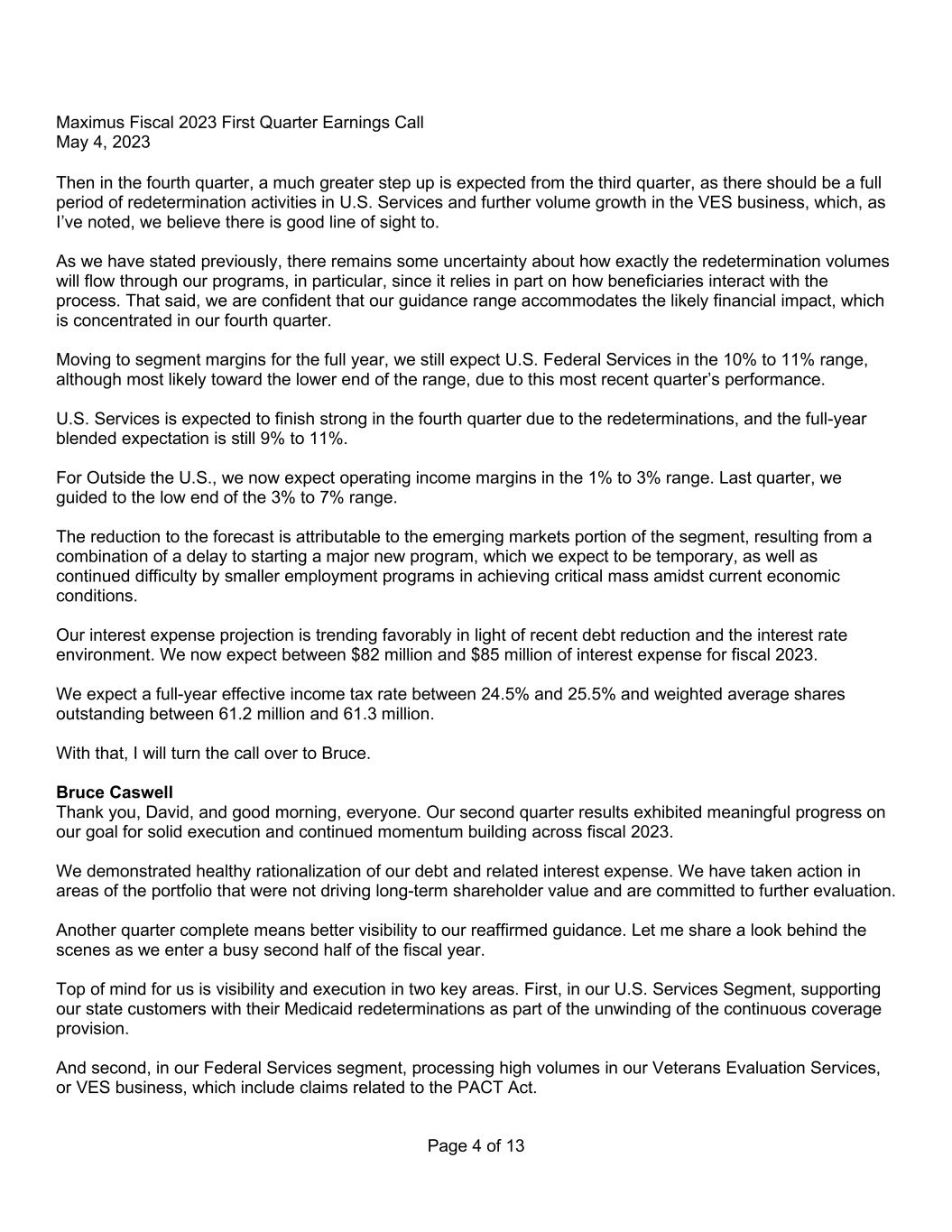
Maximus Fiscal 2023 First Quarter Earnings Call May 4, 2023 Page 4 of 13 Then in the fourth quarter, a much greater step up is expected from the third quarter, as there should be a full period of redetermination activities in U.S. Services and further volume growth in the VES business, which, as I’ve noted, we believe there is good line of sight to. As we have stated previously, there remains some uncertainty about how exactly the redetermination volumes will flow through our programs, in particular, since it relies in part on how beneficiaries interact with the process. That said, we are confident that our guidance range accommodates the likely financial impact, which is concentrated in our fourth quarter. Moving to segment margins for the full year, we still expect U.S. Federal Services in the 10% to 11% range, although most likely toward the lower end of the range, due to this most recent quarter’s performance. U.S. Services is expected to finish strong in the fourth quarter due to the redeterminations, and the full-year blended expectation is still 9% to 11%. For Outside the U.S., we now expect operating income margins in the 1% to 3% range. Last quarter, we guided to the low end of the 3% to 7% range. The reduction to the forecast is attributable to the emerging markets portion of the segment, resulting from a combination of a delay to starting a major new program, which we expect to be temporary, as well as continued difficulty by smaller employment programs in achieving critical mass amidst current economic conditions. Our interest expense projection is trending favorably in light of recent debt reduction and the interest rate environment. We now expect between $82 million and $85 million of interest expense for fiscal 2023. We expect a full-year effective income tax rate between 24.5% and 25.5% and weighted average shares outstanding between 61.2 million and 61.3 million. With that, I will turn the call over to Bruce. Bruce Caswell Thank you, David, and good morning, everyone. Our second quarter results exhibited meaningful progress on our goal for solid execution and continued momentum building across fiscal 2023. We demonstrated healthy rationalization of our debt and related interest expense. We have taken action in areas of the portfolio that were not driving long-term shareholder value and are committed to further evaluation. Another quarter complete means better visibility to our reaffirmed guidance. Let me share a look behind the scenes as we enter a busy second half of the fiscal year. Top of mind for us is visibility and execution in two key areas. First, in our U.S. Services Segment, supporting our state customers with their Medicaid redeterminations as part of the unwinding of the continuous coverage provision. And second, in our Federal Services segment, processing high volumes in our Veterans Evaluation Services, or VES business, which include claims related to the PACT Act.
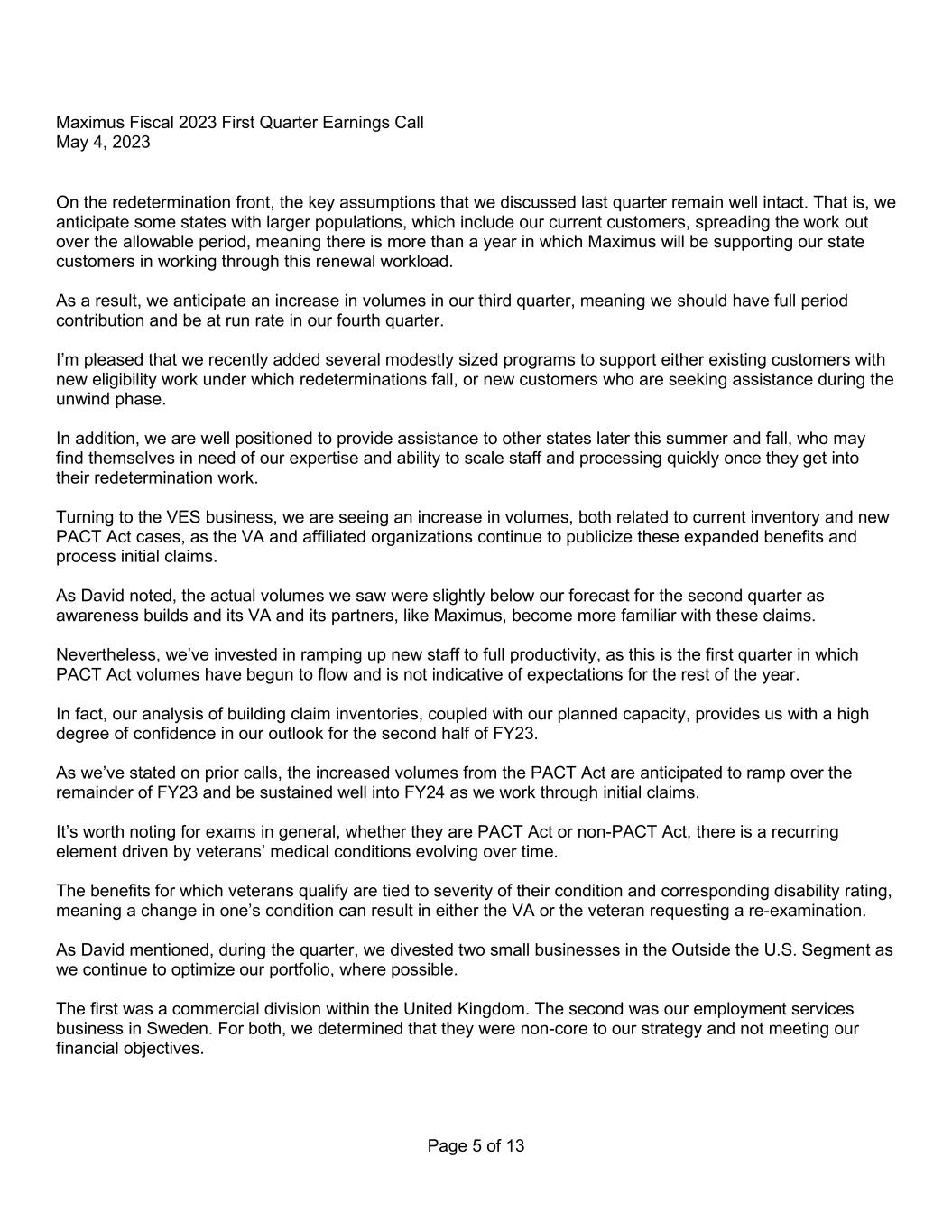
Maximus Fiscal 2023 First Quarter Earnings Call May 4, 2023 Page 5 of 13 On the redetermination front, the key assumptions that we discussed last quarter remain well intact. That is, we anticipate some states with larger populations, which include our current customers, spreading the work out over the allowable period, meaning there is more than a year in which Maximus will be supporting our state customers in working through this renewal workload. As a result, we anticipate an increase in volumes in our third quarter, meaning we should have full period contribution and be at run rate in our fourth quarter. I’m pleased that we recently added several modestly sized programs to support either existing customers with new eligibility work under which redeterminations fall, or new customers who are seeking assistance during the unwind phase. In addition, we are well positioned to provide assistance to other states later this summer and fall, who may find themselves in need of our expertise and ability to scale staff and processing quickly once they get into their redetermination work. Turning to the VES business, we are seeing an increase in volumes, both related to current inventory and new PACT Act cases, as the VA and affiliated organizations continue to publicize these expanded benefits and process initial claims. As David noted, the actual volumes we saw were slightly below our forecast for the second quarter as awareness builds and its VA and its partners, like Maximus, become more familiar with these claims. Nevertheless, we’ve invested in ramping up new staff to full productivity, as this is the first quarter in which PACT Act volumes have begun to flow and is not indicative of expectations for the rest of the year. In fact, our analysis of building claim inventories, coupled with our planned capacity, provides us with a high degree of confidence in our outlook for the second half of FY23. As we’ve stated on prior calls, the increased volumes from the PACT Act are anticipated to ramp over the remainder of FY23 and be sustained well into FY24 as we work through initial claims. It’s worth noting for exams in general, whether they are PACT Act or non-PACT Act, there is a recurring element driven by veterans’ medical conditions evolving over time. The benefits for which veterans qualify are tied to severity of their condition and corresponding disability rating, meaning a change in one’s condition can result in either the VA or the veteran requesting a re-examination. As David mentioned, during the quarter, we divested two small businesses in the Outside the U.S. Segment as we continue to optimize our portfolio, where possible. The first was a commercial division within the United Kingdom. The second was our employment services business in Sweden. For both, we determined that they were non-core to our strategy and not meeting our financial objectives.

Maximus Fiscal 2023 First Quarter Earnings Call May 4, 2023 Page 6 of 13 We routinely evaluate our portfolio of businesses in this way and will continue to do so, particularly in light of the segment’s performance this second quarter. Together, the annual revenue run rate is about $40 million. Going forward, we expect the transactions to be slightly accretive to our earnings. The financial impact, especially given the partial year, is not large enough to affect our guidance. I will now provide an update to the IRS Enterprise Development Operations Services, or EDOS, procurement, which had been under protest and is now resolved. We have secured our place on the multiple award blanket purchase agreement, worth up to $2.6 billion, over seven years, for the resulting task orders, which are expected to contribute in our fiscal year 2024 and beyond. The resolution removes uncertainty around the timing of future task orders. This is a core win in our strategic focus area of Technology Modernization and builds on our relationship with the IRS as a trusted partner. We are proud to be supporting the long-term modernization and transformation of the IRS’s technology infrastructure. Remaining in Federal, we also recently received good news for our Aidvantage business, which is aligned with our strategic focus of Customer Services, Digitally Enabled. We were just awarded a position on the successor contract vehicle known as Unified Servicing and Data Solution, or USDS, which supports our work serving student loan borrowers over the next decade and is expected to commence when the current contract concludes on December 31, 2023. The new IDIQ under the Federal Student Aid Office, or FSA, within the Department of Education spans a ten- year period, including options, and has an awarded potential value of $16 billion. We estimate more than a $2 billion realizable value for Maximus, based on Aidvantage’s projected run rate, going into the new contract. The FSA has made it clear their goal is to continue to enhance the borrower experience, to improve performance, transparency, and accountability. As a conflict-free, experienced, and trusted operator, Maximus offers the FSA a borrower-first mentality and the added agility of our technology capabilities to improve the borrower experience. We’ve been successfully operating under performance-related service level agreement metrics, which have been added to the current contracts, and we look forward to bringing innovation and borrower focus to FSA for the decade to come. To that point, we have also been entrusted with more borrower accounts, which now total over 9 million borrowers, or about a quarter of the approximately 39 million Department of Education borrower accounts, which is up from 5.8 million borrowers at the time of contract novation in October of 2021. A quick reminder that return to repayment is scheduled to begin the earlier of 60 days after the debt relief litigation is resolved in the Supreme Court, or 60 days after June 30, 2023. Debt relief would decrease our revenue, while return to repayment increases our revenue on our existing contract. As we have said before, these potential outcomes are accommodated in our FY23 guidance.
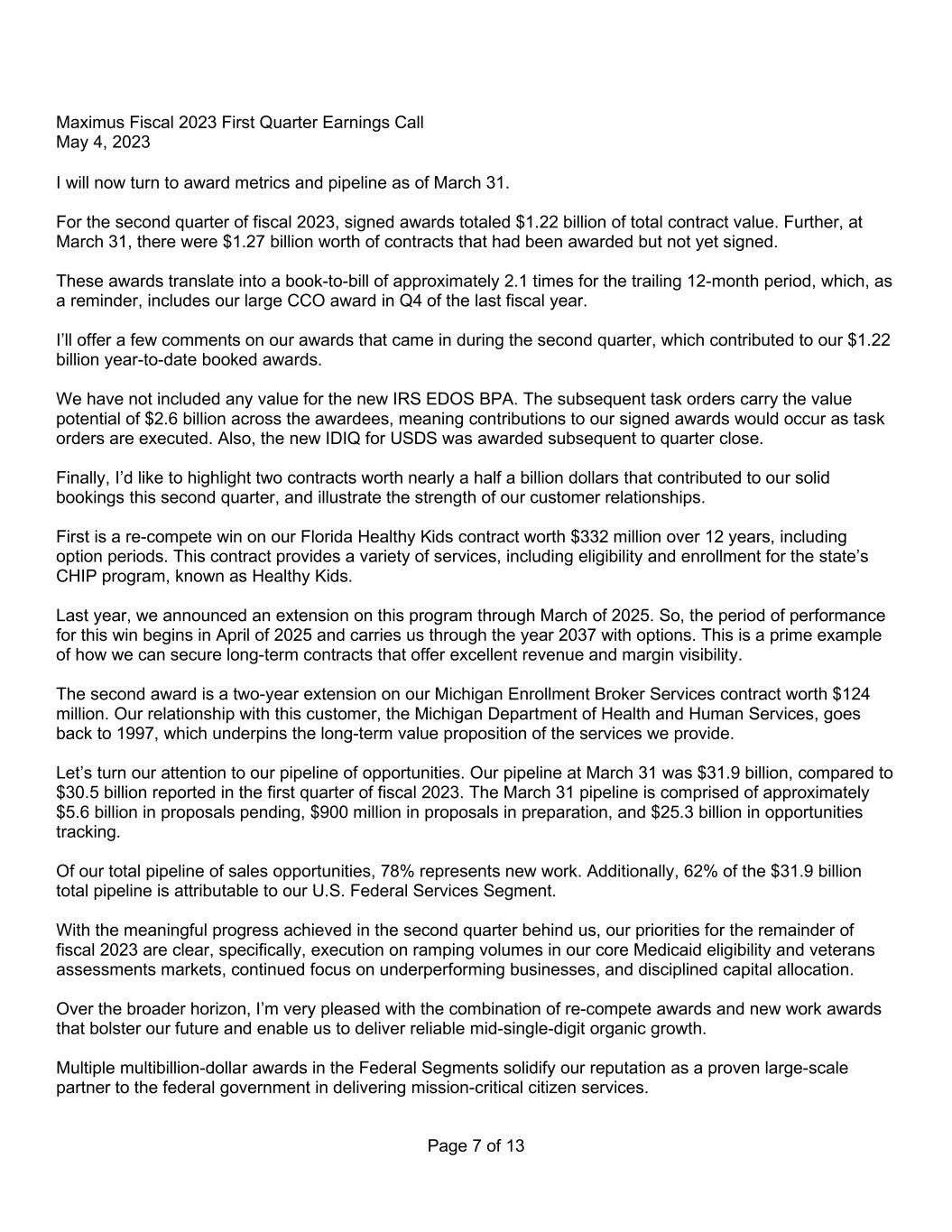
Maximus Fiscal 2023 First Quarter Earnings Call May 4, 2023 Page 7 of 13 I will now turn to award metrics and pipeline as of March 31. For the second quarter of fiscal 2023, signed awards totaled $1.22 billion of total contract value. Further, at March 31, there were $1.27 billion worth of contracts that had been awarded but not yet signed. These awards translate into a book-to-bill of approximately 2.1 times for the trailing 12-month period, which, as a reminder, includes our large CCO award in Q4 of the last fiscal year. I’ll offer a few comments on our awards that came in during the second quarter, which contributed to our $1.22 billion year-to-date booked awards. We have not included any value for the new IRS EDOS BPA. The subsequent task orders carry the value potential of $2.6 billion across the awardees, meaning contributions to our signed awards would occur as task orders are executed. Also, the new IDIQ for USDS was awarded subsequent to quarter close. Finally, I’d like to highlight two contracts worth nearly a half a billion dollars that contributed to our solid bookings this second quarter, and illustrate the strength of our customer relationships. First is a re-compete win on our Florida Healthy Kids contract worth $332 million over 12 years, including option periods. This contract provides a variety of services, including eligibility and enrollment for the state’s CHIP program, known as Healthy Kids. Last year, we announced an extension on this program through March of 2025. So, the period of performance for this win begins in April of 2025 and carries us through the year 2037 with options. This is a prime example of how we can secure long-term contracts that offer excellent revenue and margin visibility. The second award is a two-year extension on our Michigan Enrollment Broker Services contract worth $124 million. Our relationship with this customer, the Michigan Department of Health and Human Services, goes back to 1997, which underpins the long-term value proposition of the services we provide. Let’s turn our attention to our pipeline of opportunities. Our pipeline at March 31 was $31.9 billion, compared to $30.5 billion reported in the first quarter of fiscal 2023. The March 31 pipeline is comprised of approximately $5.6 billion in proposals pending, $900 million in proposals in preparation, and $25.3 billion in opportunities tracking. Of our total pipeline of sales opportunities, 78% represents new work. Additionally, 62% of the $31.9 billion total pipeline is attributable to our U.S. Federal Services Segment. With the meaningful progress achieved in the second quarter behind us, our priorities for the remainder of fiscal 2023 are clear, specifically, execution on ramping volumes in our core Medicaid eligibility and veterans assessments markets, continued focus on underperforming businesses, and disciplined capital allocation. Over the broader horizon, I’m very pleased with the combination of re-compete awards and new work awards that bolster our future and enable us to deliver reliable mid-single-digit organic growth. Multiple multibillion-dollar awards in the Federal Segments solidify our reputation as a proven large-scale partner to the federal government in delivering mission-critical citizen services.
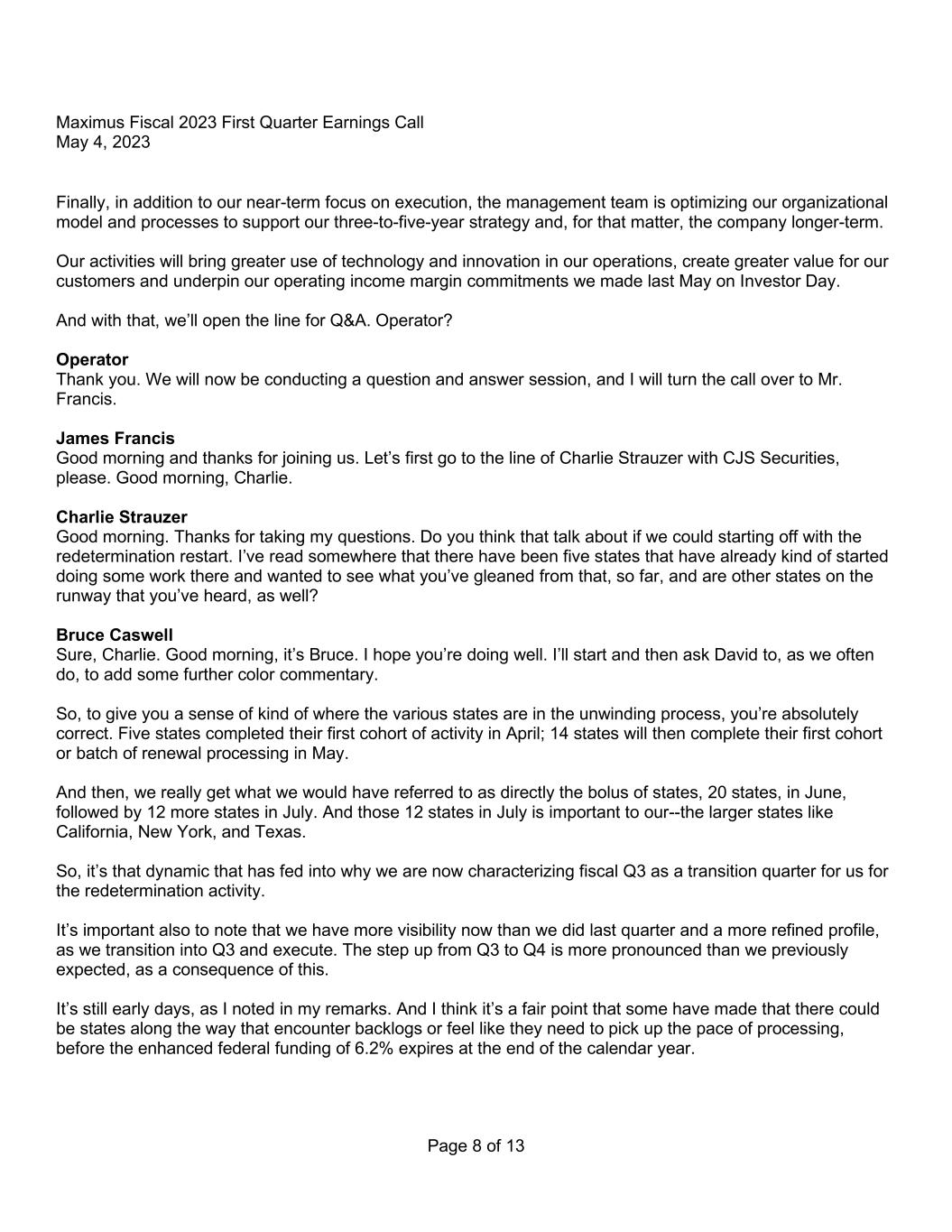
Maximus Fiscal 2023 First Quarter Earnings Call May 4, 2023 Page 8 of 13 Finally, in addition to our near-term focus on execution, the management team is optimizing our organizational model and processes to support our three-to-five-year strategy and, for that matter, the company longer-term. Our activities will bring greater use of technology and innovation in our operations, create greater value for our customers and underpin our operating income margin commitments we made last May on Investor Day. And with that, we’ll open the line for Q&A. Operator? Operator Thank you. We will now be conducting a question and answer session, and I will turn the call over to Mr. Francis. James Francis Good morning and thanks for joining us. Let’s first go to the line of Charlie Strauzer with CJS Securities, please. Good morning, Charlie. Charlie Strauzer Good morning. Thanks for taking my questions. Do you think that talk about if we could starting off with the redetermination restart. I’ve read somewhere that there have been five states that have already kind of started doing some work there and wanted to see what you’ve gleaned from that, so far, and are other states on the runway that you’ve heard, as well? Bruce Caswell Sure, Charlie. Good morning, it’s Bruce. I hope you’re doing well. I’ll start and then ask David to, as we often do, to add some further color commentary. So, to give you a sense of kind of where the various states are in the unwinding process, you’re absolutely correct. Five states completed their first cohort of activity in April; 14 states will then complete their first cohort or batch of renewal processing in May. And then, we really get what we would have referred to as directly the bolus of states, 20 states, in June, followed by 12 more states in July. And those 12 states in July is important to our--the larger states like California, New York, and Texas. So, it’s that dynamic that has fed into why we are now characterizing fiscal Q3 as a transition quarter for us for the redetermination activity. It’s important also to note that we have more visibility now than we did last quarter and a more refined profile, as we transition into Q3 and execute. The step up from Q3 to Q4 is more pronounced than we previously expected, as a consequence of this. It’s still early days, as I noted in my remarks. And I think it’s a fair point that some have made that there could be states along the way that encounter backlogs or feel like they need to pick up the pace of processing, before the enhanced federal funding of 6.2% expires at the end of the calendar year.
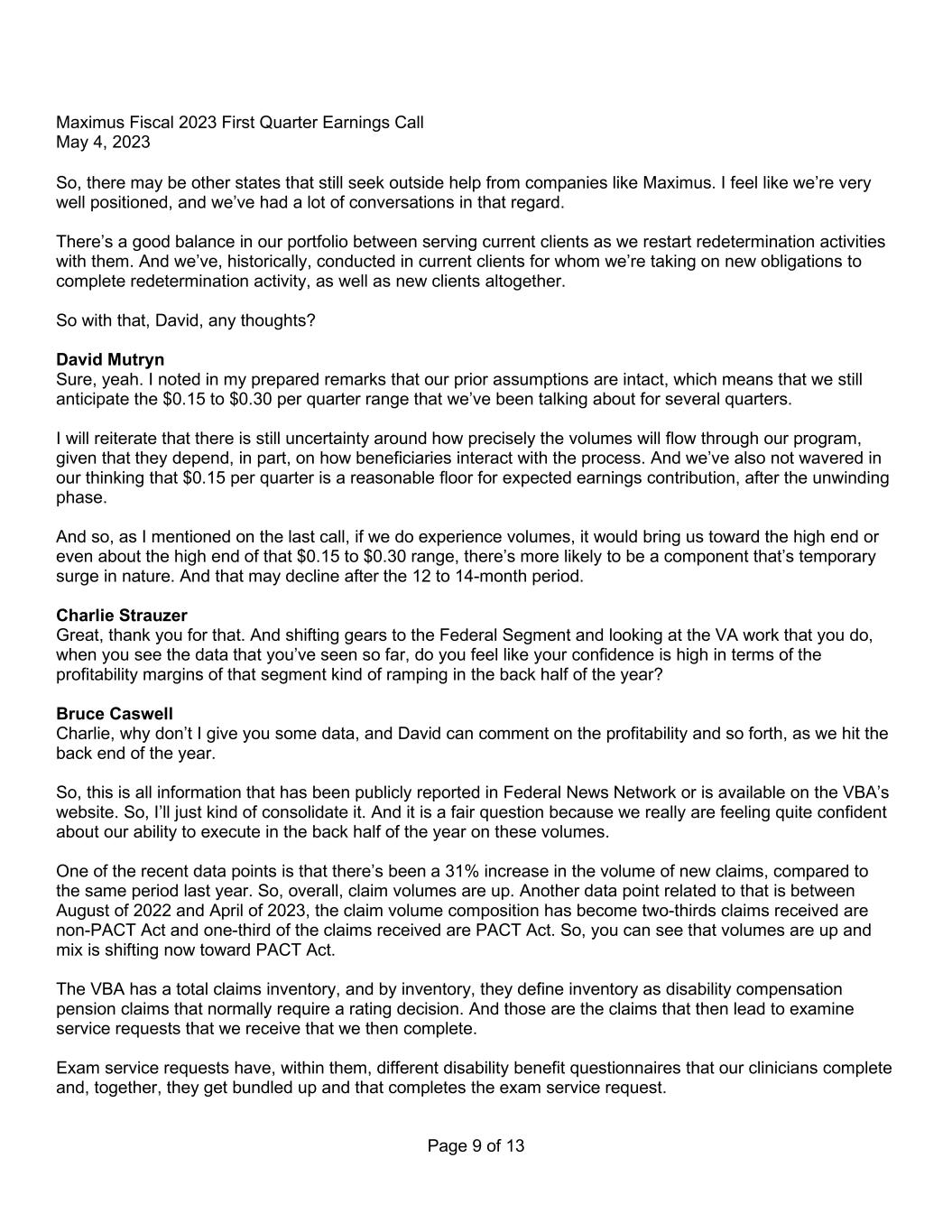
Maximus Fiscal 2023 First Quarter Earnings Call May 4, 2023 Page 9 of 13 So, there may be other states that still seek outside help from companies like Maximus. I feel like we’re very well positioned, and we’ve had a lot of conversations in that regard. There’s a good balance in our portfolio between serving current clients as we restart redetermination activities with them. And we’ve, historically, conducted in current clients for whom we’re taking on new obligations to complete redetermination activity, as well as new clients altogether. So with that, David, any thoughts? David Mutryn Sure, yeah. I noted in my prepared remarks that our prior assumptions are intact, which means that we still anticipate the $0.15 to $0.30 per quarter range that we’ve been talking about for several quarters. I will reiterate that there is still uncertainty around how precisely the volumes will flow through our program, given that they depend, in part, on how beneficiaries interact with the process. And we’ve also not wavered in our thinking that $0.15 per quarter is a reasonable floor for expected earnings contribution, after the unwinding phase. And so, as I mentioned on the last call, if we do experience volumes, it would bring us toward the high end or even about the high end of that $0.15 to $0.30 range, there’s more likely to be a component that’s temporary surge in nature. And that may decline after the 12 to 14-month period. Charlie Strauzer Great, thank you for that. And shifting gears to the Federal Segment and looking at the VA work that you do, when you see the data that you’ve seen so far, do you feel like your confidence is high in terms of the profitability margins of that segment kind of ramping in the back half of the year? Bruce Caswell Charlie, why don’t I give you some data, and David can comment on the profitability and so forth, as we hit the back end of the year. So, this is all information that has been publicly reported in Federal News Network or is available on the VBA’s website. So, I’ll just kind of consolidate it. And it is a fair question because we really are feeling quite confident about our ability to execute in the back half of the year on these volumes. One of the recent data points is that there’s been a 31% increase in the volume of new claims, compared to the same period last year. So, overall, claim volumes are up. Another data point related to that is between August of 2022 and April of 2023, the claim volume composition has become two-thirds claims received are non-PACT Act and one-third of the claims received are PACT Act. So, you can see that volumes are up and mix is shifting now toward PACT Act. The VBA has a total claims inventory, and by inventory, they define inventory as disability compensation pension claims that normally require a rating decision. And those are the claims that then lead to examine service requests that we receive that we then complete. Exam service requests have, within them, different disability benefit questionnaires that our clinicians complete and, together, they get bundled up and that completes the exam service request.
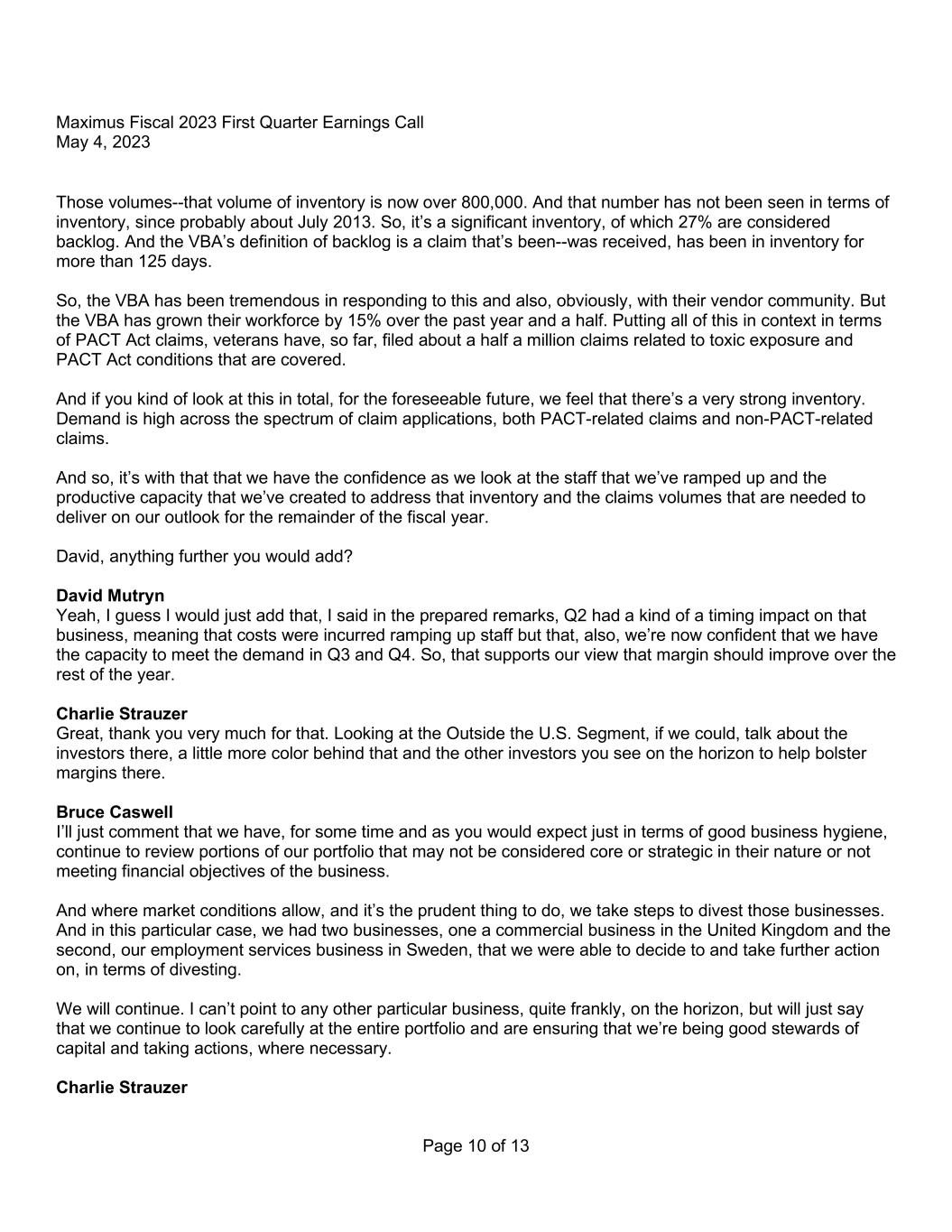
Maximus Fiscal 2023 First Quarter Earnings Call May 4, 2023 Page 10 of 13 Those volumes--that volume of inventory is now over 800,000. And that number has not been seen in terms of inventory, since probably about July 2013. So, it’s a significant inventory, of which 27% are considered backlog. And the VBA’s definition of backlog is a claim that’s been--was received, has been in inventory for more than 125 days. So, the VBA has been tremendous in responding to this and also, obviously, with their vendor community. But the VBA has grown their workforce by 15% over the past year and a half. Putting all of this in context in terms of PACT Act claims, veterans have, so far, filed about a half a million claims related to toxic exposure and PACT Act conditions that are covered. And if you kind of look at this in total, for the foreseeable future, we feel that there’s a very strong inventory. Demand is high across the spectrum of claim applications, both PACT-related claims and non-PACT-related claims. And so, it’s with that that we have the confidence as we look at the staff that we’ve ramped up and the productive capacity that we’ve created to address that inventory and the claims volumes that are needed to deliver on our outlook for the remainder of the fiscal year. David, anything further you would add? David Mutryn Yeah, I guess I would just add that, I said in the prepared remarks, Q2 had a kind of a timing impact on that business, meaning that costs were incurred ramping up staff but that, also, we’re now confident that we have the capacity to meet the demand in Q3 and Q4. So, that supports our view that margin should improve over the rest of the year. Charlie Strauzer Great, thank you very much for that. Looking at the Outside the U.S. Segment, if we could, talk about the investors there, a little more color behind that and the other investors you see on the horizon to help bolster margins there. Bruce Caswell I’ll just comment that we have, for some time and as you would expect just in terms of good business hygiene, continue to review portions of our portfolio that may not be considered core or strategic in their nature or not meeting financial objectives of the business. And where market conditions allow, and it’s the prudent thing to do, we take steps to divest those businesses. And in this particular case, we had two businesses, one a commercial business in the United Kingdom and the second, our employment services business in Sweden, that we were able to decide to and take further action on, in terms of divesting. We will continue. I can’t point to any other particular business, quite frankly, on the horizon, but will just say that we continue to look carefully at the entire portfolio and are ensuring that we’re being good stewards of capital and taking actions, where necessary. Charlie Strauzer
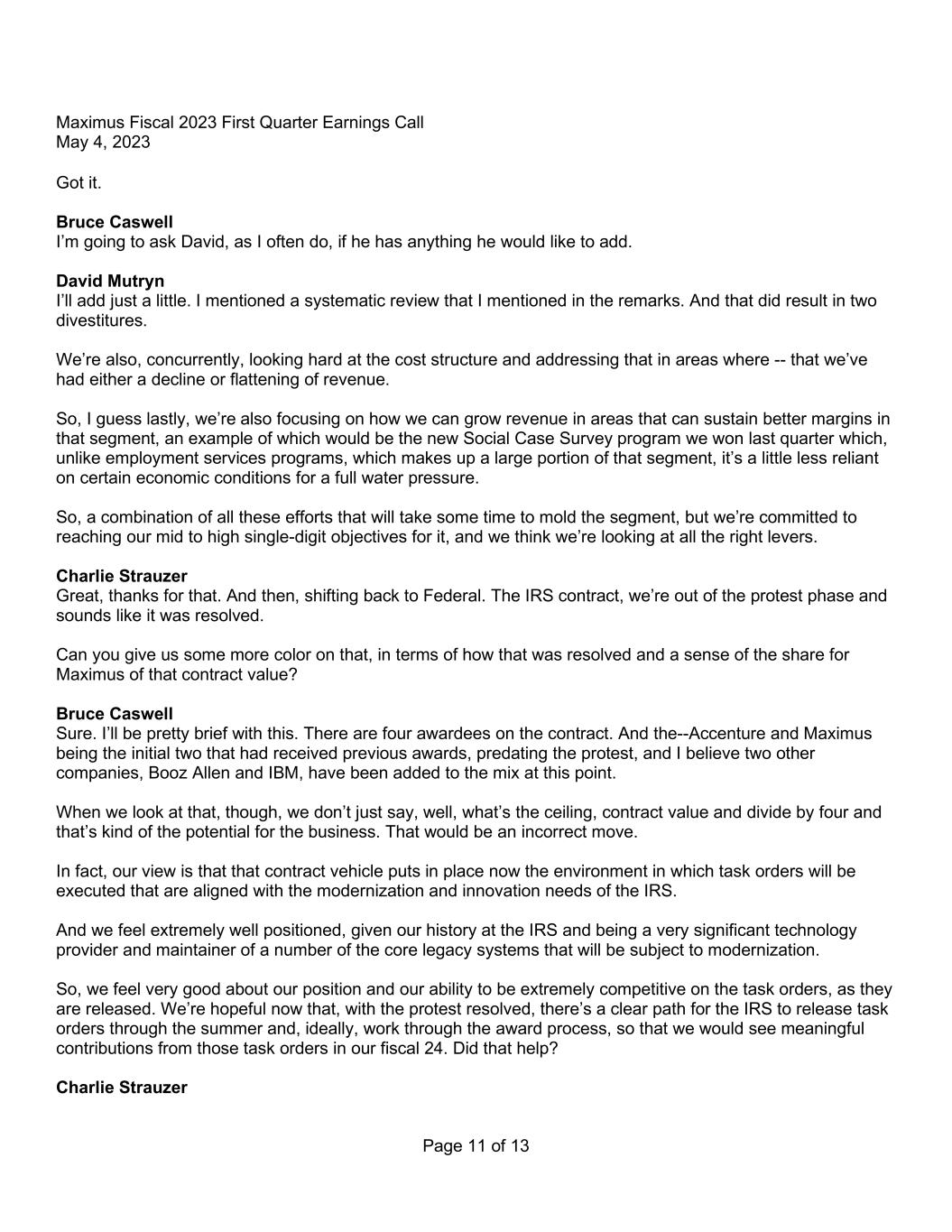
Maximus Fiscal 2023 First Quarter Earnings Call May 4, 2023 Page 11 of 13 Got it. Bruce Caswell I’m going to ask David, as I often do, if he has anything he would like to add. David Mutryn I’ll add just a little. I mentioned a systematic review that I mentioned in the remarks. And that did result in two divestitures. We’re also, concurrently, looking hard at the cost structure and addressing that in areas where -- that we’ve had either a decline or flattening of revenue. So, I guess lastly, we’re also focusing on how we can grow revenue in areas that can sustain better margins in that segment, an example of which would be the new Social Case Survey program we won last quarter which, unlike employment services programs, which makes up a large portion of that segment, it’s a little less reliant on certain economic conditions for a full water pressure. So, a combination of all these efforts that will take some time to mold the segment, but we’re committed to reaching our mid to high single-digit objectives for it, and we think we’re looking at all the right levers. Charlie Strauzer Great, thanks for that. And then, shifting back to Federal. The IRS contract, we’re out of the protest phase and sounds like it was resolved. Can you give us some more color on that, in terms of how that was resolved and a sense of the share for Maximus of that contract value? Bruce Caswell Sure. I’ll be pretty brief with this. There are four awardees on the contract. And the--Accenture and Maximus being the initial two that had received previous awards, predating the protest, and I believe two other companies, Booz Allen and IBM, have been added to the mix at this point. When we look at that, though, we don’t just say, well, what’s the ceiling, contract value and divide by four and that’s kind of the potential for the business. That would be an incorrect move. In fact, our view is that that contract vehicle puts in place now the environment in which task orders will be executed that are aligned with the modernization and innovation needs of the IRS. And we feel extremely well positioned, given our history at the IRS and being a very significant technology provider and maintainer of a number of the core legacy systems that will be subject to modernization. So, we feel very good about our position and our ability to be extremely competitive on the task orders, as they are released. We’re hopeful now that, with the protest resolved, there’s a clear path for the IRS to release task orders through the summer and, ideally, work through the award process, so that we would see meaningful contributions from those task orders in our fiscal 24. Did that help? Charlie Strauzer
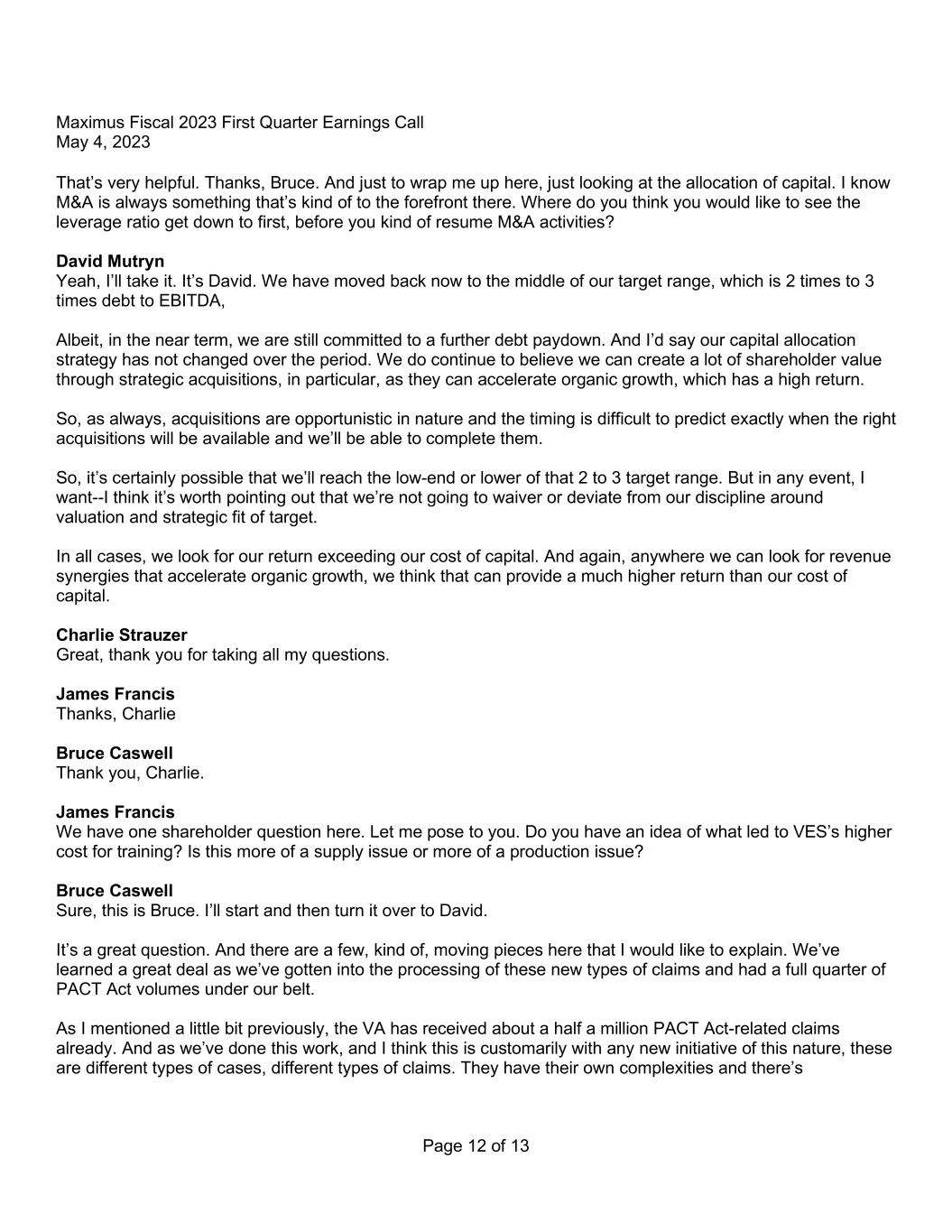
Maximus Fiscal 2023 First Quarter Earnings Call May 4, 2023 Page 12 of 13 That’s very helpful. Thanks, Bruce. And just to wrap me up here, just looking at the allocation of capital. I know M&A is always something that’s kind of to the forefront there. Where do you think you would like to see the leverage ratio get down to first, before you kind of resume M&A activities? David Mutryn Yeah, I’ll take it. It’s David. We have moved back now to the middle of our target range, which is 2 times to 3 times debt to EBITDA, Albeit, in the near term, we are still committed to a further debt paydown. And I’d say our capital allocation strategy has not changed over the period. We do continue to believe we can create a lot of shareholder value through strategic acquisitions, in particular, as they can accelerate organic growth, which has a high return. So, as always, acquisitions are opportunistic in nature and the timing is difficult to predict exactly when the right acquisitions will be available and we’ll be able to complete them. So, it’s certainly possible that we’ll reach the low-end or lower of that 2 to 3 target range. But in any event, I want--I think it’s worth pointing out that we’re not going to waiver or deviate from our discipline around valuation and strategic fit of target. In all cases, we look for our return exceeding our cost of capital. And again, anywhere we can look for revenue synergies that accelerate organic growth, we think that can provide a much higher return than our cost of capital. Charlie Strauzer Great, thank you for taking all my questions. James Francis Thanks, Charlie Bruce Caswell Thank you, Charlie. James Francis We have one shareholder question here. Let me pose to you. Do you have an idea of what led to VES’s higher cost for training? Is this more of a supply issue or more of a production issue? Bruce Caswell Sure, this is Bruce. I’ll start and then turn it over to David. It’s a great question. And there are a few, kind of, moving pieces here that I would like to explain. We’ve learned a great deal as we’ve gotten into the processing of these new types of claims and had a full quarter of PACT Act volumes under our belt. As I mentioned a little bit previously, the VA has received about a half a million PACT Act-related claims already. And as we’ve done this work, and I think this is customarily with any new initiative of this nature, these are different types of cases, different types of claims. They have their own complexities and there’s

Maximus Fiscal 2023 First Quarter Earnings Call May 4, 2023 Page 13 of 13 correspondingly a ramp-up or a learning curve for both organizations, for the vendor supporting the VA and for the VA, itself. So, in this early period of transition, we’re both in the process of formalizing our procedures and ensuring that we have kind of a grooved swing, if you will, for handling these types of cases. It’s not uncommon for new claim types of this nature for there to be a back-and-forth between the vendor and the VA to clarify issues, address questions, and so forth. And another interesting data point is the VBA has reported recently that the average number of days to process from start to finish, a PACT Act-related claim, is about 156 and a half days, as a data point. In the second quarter, another one of the elements in the moving parts here was the utilization of our staff was a bit below our potential. We had more stuff completing training and, therefore, fewer in production, which led to more overtime, and then what had been anticipated for the fully productive staff that we already had. And as I noted in my remarks, the demand is building at an increasing rate. And so, since late FY 22, you’ll recall that we’ve been making investments and lining up the business to meet the anticipated demand, and we’re very confident in our ability to have the productive capacity in place required to achieve our forecast. With that, David, anything further to add? David Mutryn Yeah, just to lay on to Bruce’s remarks, while revenue was a bit lower than we had forecast in the quarter, the bottom line impact was amplified, due to the higher cost, as you mentioned, with the ramping up of staff to meet our expectations for Q3 and Q4. James Francis That’s great. That concludes the question and answer session. Thanks for joining us today. Operator, back to you. Operator Ladies and gentlemen, thank you for your participation and interest in Maximus. You may disconnect your lines and log off the webcast at this time, and enjoy the rest of your day.